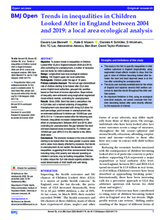Abstract
Objective To assess trends in inequalities in Children Looked After (CLA) in England between 2004 and 2019, after controlling for unemployment, a marker of recession and risk factor for child maltreatment.
Design Longitudinal local area ecological analysis.
Setting 150 English upper-tier local authorities.
Participants Children under the age of 18 years.
Primary outcome measure The annual age-standardised rate of children starting to be looked after (CLA rate) across English local authorities, grouped into quintiles based on their level of income deprivation. Slope indices of inequality were estimated using longitudinal segmented mixed-effects models, controlling for unemployment.
Results Since 2008, there has been a precipitous rise in CLA rates and a marked widening of inequalities. Unemployment was associated with rising CLA rates: for each percentage point increase in unemployment rate, an estimated additional 9 children per 100 000 per year (95% CI 6 to 11) became looked after the following year. However, inequalities increased independently of the effect of unemployment. Between 2007 and 2019, after controlling for unemployment, the gap between the most and least deprived areas increased by 15 children per 100 000 per year (95% CI 4 to 26) relative to the 2004–2006 trend.
Conclusions The dramatic increase in the rate of children starting to be looked after has been greater in poorer areas and in areas more deeply affected by recession. But trends in unemployment do not explain the decade-long rise in inequalities, suggesting that other socioeconomic factors, including rising child poverty and reduced spending on children’s services, may be fuelling inequalities. Policies to safely reduce the CLA rate should urgently address the social determinants of child health and well-being.

